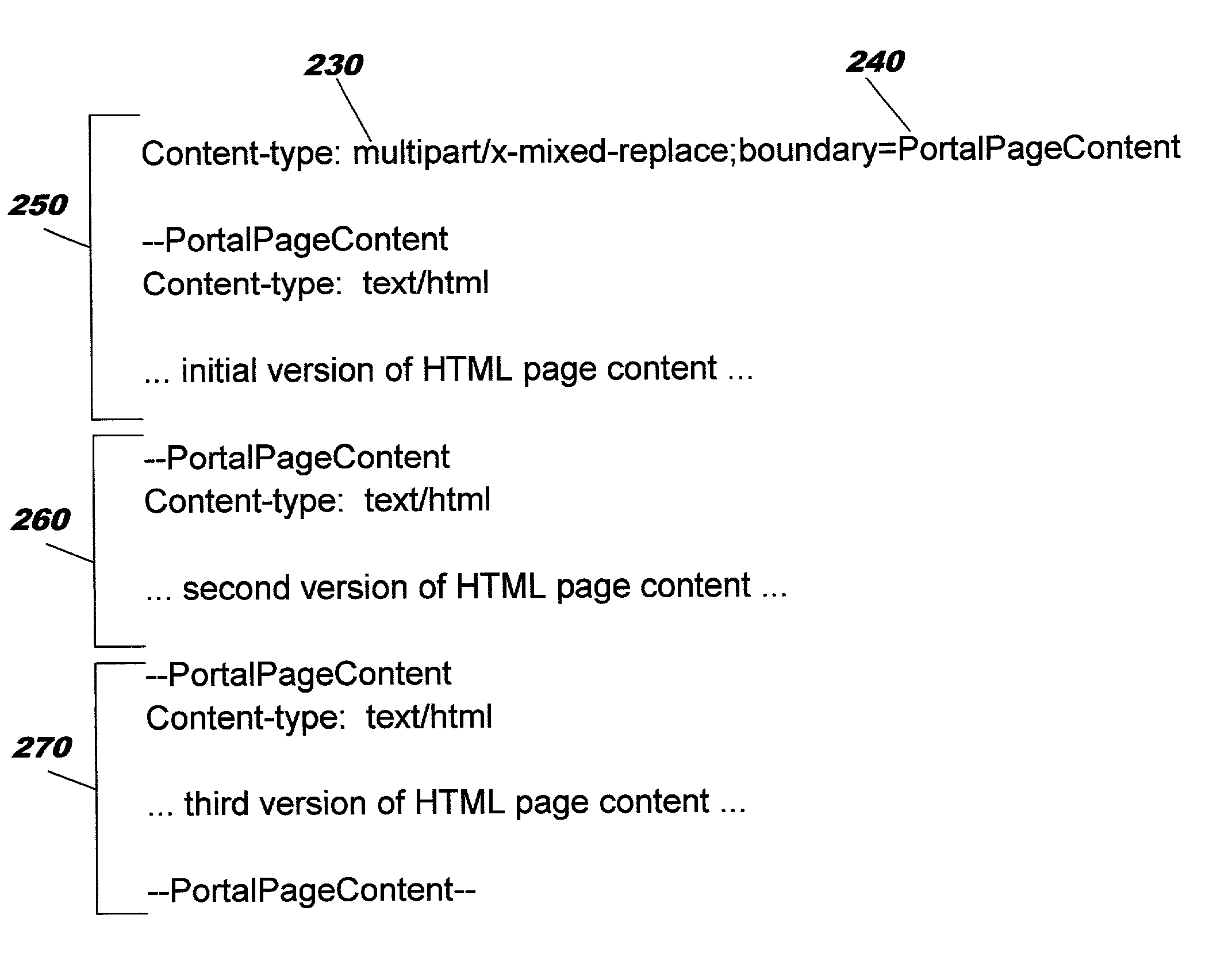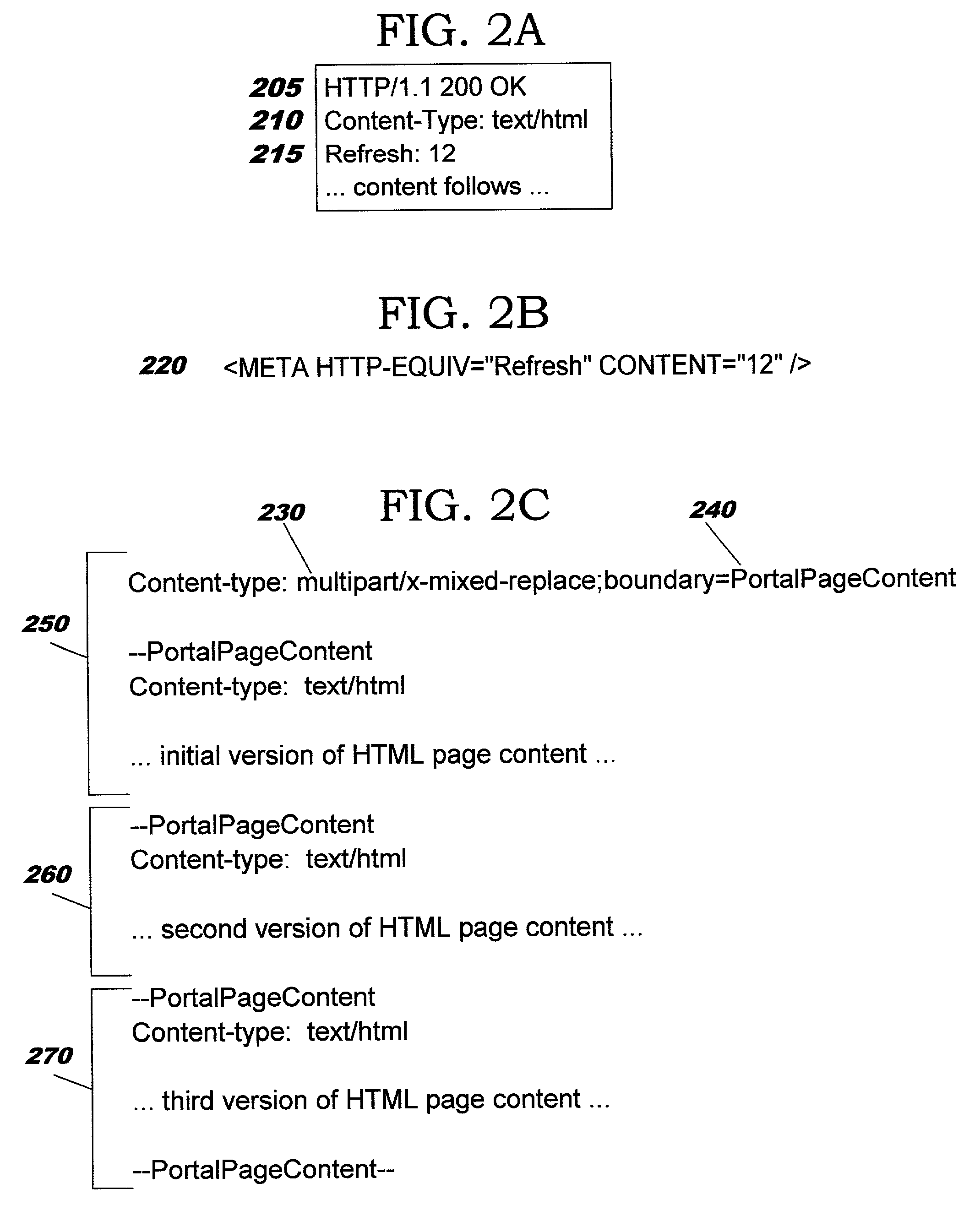Low-latency, incremental rendering in a content framework
- Summary
- Abstract
- Description
- Claims
- Application Information
AI Technical Summary
Problems solved by technology
Method used
Image
Examples
first embodiment
[0029] FIGS. 2A and 2B provide examples of syntax that may be used for incremental portal page rendering according to the present invention. FIG. 2A illustrates an HTTP response message sent to a browser when transmitting an initial partially-complete portal page. In this example, the response header shown in FIG. 2A indicates the following information: (1) the status is "OK" (see element 205); (2) the content type of this response message is "text / html" (see element 210); and (3) the content delivered with this response message should be refreshed, for this example, after waiting 12 seconds (see element 215). An alternative syntax is shown in FIG. 2B, which uses a Hypertext Markup Language ("HTML") META tag with an HTTP-EQUIV attribute, as shown at 220. In general, a META tag may be used to identify properties of a document, and an HTTP-EQUIV attribute on a META tag may be used in markup language documents to explicitly specify information that an HTTP server should convey in the H...
second embodiment
[0034] Turning now to FIG. 2C, an example is provided of syntax that may be used for incremental portal page rendering according to the present invention. The MIME type of "multipart / x-mixed-replace" is used for the content type header in the HTTP response with which the portal page is delivered to the requester, as shown at 230, to indicate that content appearing within data blocks denoted by successive "boundary" elements is to replace the content rendered from earlier data blocks. The boundary attribute in this example specifies that the string "PortalPageContent" (see 240) is used to delimit the data blocks. When using this embodiment, an initial partially-complete portal page is specified as the first data block, and follows the first occurrence of the boundary delimiter. This portion 250 of the document shown in FIG. 2C is then transmitted to the browser, where it will be rendered. When additional portlet content is acquired, the markup language document specifying the portal ...
fourth embodiment
[0038] In the present invention, if the content of all portlets is not ready when the immediate response is being formatted for delivery to the requesting browser, a hyperlink is programmatically inserted into the initial version of the markup language document which represents the portal page. Preferably, a descriptive message is also inserted, instructing the user that clicking on this hyperlink will request a revised version of the portal page (or when frames are used for the page, a revised version of the frame with which the hyperlink is associated). The URL for the hyperlink is then the same URL used to originally request the content of the portal page (or of the frame, respectively). Conversely, if a content request is received and all the content is ready (whether on the initial request or a subsequent request), the hyperlink is omitted.
[0039] Referring now to the flowcharts in FIGS. 4-6, logic depicting operations of preferred embodiments of the present invention will now b...
PUM
 Login to View More
Login to View More Abstract
Description
Claims
Application Information
 Login to View More
Login to View More - R&D
- Intellectual Property
- Life Sciences
- Materials
- Tech Scout
- Unparalleled Data Quality
- Higher Quality Content
- 60% Fewer Hallucinations
Browse by: Latest US Patents, China's latest patents, Technical Efficacy Thesaurus, Application Domain, Technology Topic, Popular Technical Reports.
© 2025 PatSnap. All rights reserved.Legal|Privacy policy|Modern Slavery Act Transparency Statement|Sitemap|About US| Contact US: help@patsnap.com



